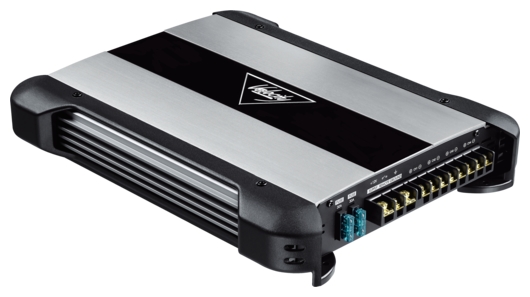Blaupunkt Velocity VA475
A truly unique feature of this amplifier is its triple signal input capabilities. You can go in on RCAs as normal or also in exactly the same way as the Diamond Audio D1 300.4, you can go in on paired multi-pin connectors to speaker wires. However, right next to these ‘Hi Input’ connectors, there is a 3.5mm tip-ring-sleeve socket that can take an audio signal from the sort of microjack plug that is used to output tunes from just about everything with an analogue audio out. You might need to ‘Y’ lead your microjack lead and in all honesty I am not certain of the benefits of this extra facility. If you have to go and get a microjack Y lead, might you not find it easier to simply get an RCA adaptor loom? Anyway it shows thought and an effort to keep up to the minute with the ways in which folks are toting their music around. In theory, there is nothing to stop you from using your Blaupunkt Velocity VA475 amplifier and any appended speakers without any kind of headunit at all, simply plugging in an iPod or a Zune, or perhaps the tuneful output of a Blaupunkt Lucca navigator. (We have one here to test and will get at it ASAP.)
The Aluminium extrusion is slightly similar to that of the Diamond Audio in that the fins for cooling run along the edges of the amplifier, leaving the top plate smooth and fin free. A black panel is inlaid within this top that carries the Velocity logo. The terminals are all on one end with signal input and controls on the other as per normal and the wires affix via screw downs that are Gold plated. The power terminals are bigger than the speaker ones.
On the drop with the controls the potentiometers actually have knobs on them instead of the more normal inset type with a screwdriver slot to tweak and adjust. The ends bear a plastic moulding that sticks out enough to protect them. You get a zero to +12dB bass boost knob for each pair of channels and you get a knob each for highpass and lowpass but each covers the same 50Hz to 250Hz range so I don’t really get why you need four knobs when each pair of channels also has a selector switch to choose Highpass, Lowpass or Flat, so how can you benefit from having both controls if only one can be used?
– Class AB
– 4 x 75w RMS @ 4 Ohms
– 4 x 105w RMS @ 2 Ohms
– 2 x 210w RMS @ 4 Ohms bridged
– Extruded Aluminium heatsink with dull grey brushed finish, tough polymer side cheeks/mounts and black inlaid panel with Velocity logo on the top
– 8Ga. Power terminals with screw down plate type connection
– High level connection via dual multi pin sockets looms supplied
– Aux in dual stereo micro jack 3.5mm tip-ring-sleeve audio connection (300mV input)
– Gold plated 4Ch RCA input
– 0 to 12dB Bass Boost, frequency not quoted
– Input sensitivity: 300mV to 8V
– Stereo & bridged operation
– Frequency response 10Hz to 35kHz
– Signal to Noise Ratio 95dB
– Channel separation not quoted
– High Pass Filter & Low Pass Filters variable 50Hz to 250kHz
– Fuse Rating 30A x 2
– HxWxD(mm) 54 x 353 x 667mm
Review by Adam Rayner
Whereas all the other amps in this affordable group are all pegged to the self same £200 price point, Blaupunkt have priced this Velocity amp with huge aggression, making it a truly bargain-struck £182.99, which doesn’t even adhere to the ‘price point’ theory of things being priced to round fivers, at least!
Where other amps use four filters to permit bandpass and even subsonic filter use, the Velocity VA475 seems to be using fixed-direction filters instead of allowing the selection switch to also change the direction of the filter. I cannot help but wonder if it mightn’t have been better if the filters could be used at the same time? However, while Blaupunkt’s Velocity line might be about the next level up for many folks, they are definitely massive players and so by definition must be dealing in truly mainstream easy to grasp items. The abstruse and cunning nature of the crossovers on the likes of the Diamond Audio and SPL Dynamics amplifiers might stump the regular Joe.
The Velocity offered up a big brash sound and lacked any real sweetness to the top end frequencies. In that it was a lot like the Kicker ZX200.4 but without that item’s fat leading edge to big hits on drums and so forth.
The German market for whom this is home-designed product are one of the most discerning in the world (they gave us the terms ‘Spitzenclasse’ and the like) and this is the upper range for their most famous brand and as such it does offer a slice of real quality for what is even sillier cheap money than others in the group.
Absurdly easy to set up and use, I found yet again that I was simply sitting and listening to music rather than getting on with the serious business of trying to tell these six amplifiers apart. For all its medium size, this amplifier was the second biggest in declared output and the second most able when it came to deflecting the display on the resident AudioControl SA-3055 RTA used here in SPL or loudness measuring mode with a really rather large 125.5dB rippling around the window sill behind me. The microphone tripod was put there so I could leave it in exactly the same place for all the amplifiers I test – eighteen in total!
Overall 8.6
Sound Quality 8
Power Output 9
Features 8
Build Quality 8
Value For Money 10

